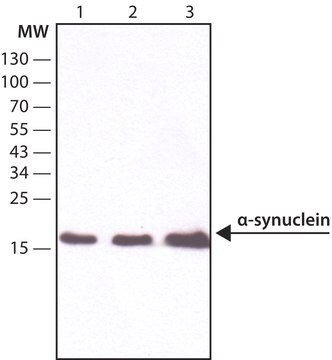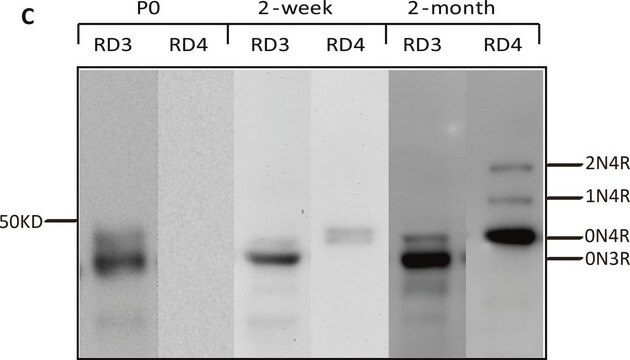ABN2265
Anti-α-Synuclein (SNCA) Antibody
rabbit polyclonal
Synonym(e):
oligomeric alpha-synuclein, Non-A beta component of AD amyloid, Non-A4 component of amyloid precursor, NACP
About This Item
Empfohlene Produkte
Produktbezeichnung
Anti-alpha-Synuclein Antibody, oligomer-specific Syn33, from rabbit
Biologische Quelle
rabbit
Qualitätsniveau
Antikörperform
purified antibody
Antikörper-Produkttyp
primary antibodies
Klon
polyclonal
Speziesreaktivität
human
Verpackung
antibody small pack of 25 μg
Methode(n)
ELISA: suitable
immunofluorescence: suitable
inhibition assay: suitable
western blot: suitable
Isotyp
IgG
UniProt-Hinterlegungsnummer
Posttranslationale Modifikation Target
unmodified
Angaben zum Gen
human ... SNCA(6622)
Allgemeine Beschreibung
Spezifität
Immunogen
Anwendung
Apoptose & Krebs
Western Blotting Analysis: A representative lot detected recombinant alpha-Synuclein, oligomers. (Sengupta, U., et. al. (2015). Biol Psychiatry. 78(10):672-83).
Western Blotting Analysis: A representative lot detected recombinant alpha-Synuclein, oligomer. (Courtesy of Dr. Rakez Kayed′s laboratory at University of Texas Medical Branch, Galveston).
ELISA Analysis: A representative lot detected alpha-Synuclein, oligomers in ELISA application (Sengupta, U., et. al. (2015). Biol Psychiatry. 78(10):672-83).
Inhibition Analysis: A representative lot inhibited cytotoxicity exerted alpha-synuclein oligomers in human neuroblastoma SH-SY5Y cells measured by MTT-based assay (Sengupta, U., et. al. (2015). Biol Psychiatry. 78(10):672-83).
Qualität
Western Blotting Analysis: A 1:500 dilution of this antibody detected alpha-Synuclein in alpha Synuclein aggregates.
Physikalische Form
Lagerung und Haltbarkeit
Sonstige Hinweise
Haftungsausschluss
Sie haben nicht das passende Produkt gefunden?
Probieren Sie unser Produkt-Auswahlhilfe. aus.
Empfehlung
Lagerklassenschlüssel
12 - Non Combustible Liquids
WGK
WGK 1
Flammpunkt (°F)
Not applicable
Flammpunkt (°C)
Not applicable
Analysenzertifikate (COA)
Suchen Sie nach Analysenzertifikate (COA), indem Sie die Lot-/Chargennummer des Produkts eingeben. Lot- und Chargennummern sind auf dem Produktetikett hinter den Wörtern ‘Lot’ oder ‘Batch’ (Lot oder Charge) zu finden.
Besitzen Sie dieses Produkt bereits?
In der Dokumentenbibliothek finden Sie die Dokumentation zu den Produkten, die Sie kürzlich erworben haben.
Unser Team von Wissenschaftlern verfügt über Erfahrung in allen Forschungsbereichen einschließlich Life Science, Materialwissenschaften, chemischer Synthese, Chromatographie, Analytik und vielen mehr..
Setzen Sie sich mit dem technischen Dienst in Verbindung.








